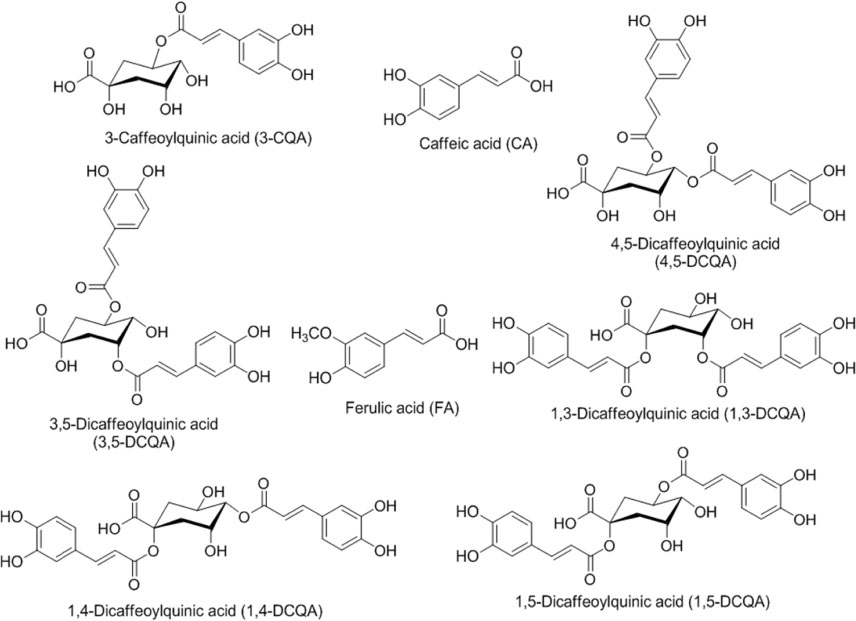Nat Prod Sci.
2018 Sep;24(3):206-212. 10.20307/nps.2018.24.3.206.
Simultaneous Determination of the Seven Phenylpropanoids in Xanthii Fructus Using a HPLC-PDA and LC-MS
- Affiliations
-
- 1Herbal Medicine Research Division, Korea Institute of Oriental Medicine, Daejeon 34054, Korea. hkshin@kiom.re.kr
- KMID: 2422014
- DOI: http://doi.org/10.20307/nps.2018.24.3.206
Abstract
- Xanthii Fructus has been traditionally used for the treatment of rhinitis, rheumatoid arthritis, and eczema. In this study, a high-performance liquid chromatography-photodiode array (HPLC-PDA) method was developed and then used for the simultaneous analysis of eight phenylpropanoids in Xanthii Fructus. The analytical column used for this separation was a SunFireâ„¢ Câ‚₈ column, maintained at 40℃. The mobile phase used was 1.0% acetic acid in distilled water and 1.0% acetic acid in acetonitrile with gradient elution. For identify of each component, the mass spectrometer (MS) was used a Waters triple quadrupole mass spectrometer requipped with electrospray ionization (ESI) source. The HPLC-PDA method showed good linearity: correlation coefficients were ≥ 0.9996. The limits of detection and quantification of the eight compounds were 0.02 - 0.04 and 0.06 - 0.14 µg/mL, respectively. The extraction recoveries ranged from 97.51 to 108.67%. The relative standard deviation values of intra- and inter-day precision were 0.06 - 1.55 and 0.09 - 1.68%, respectively. The validated HPLC-PDA method was applied to simultaneously analyse the amounts of eight phenlypropanoids in Xanthii Fructus.
Keyword
MeSH Terms
Figure
Reference
-
1. Bae KH. The medicinal plants of Korea. Seoul: Kyo-Hak Publishing;2000. p. 514.2. Shin SW, Lee JH, Bang KS. Korean J Plant Resour. 2012; 25:372–378.3. Lee YM, Kang DG, Kim MG, Choi DH, Lee HS. Korean J Orient Physiol Pathol. 2004; 18:792–796.4. Huang MH, Wang BS, Chiu CS, Amagaya S, Hsieh WT, Huang SS, Shie PH, Huang GJ. J Ethnopharmacol. 2011; 135:545–552.5. Lin B, Zhao Y, Han P, Yue W, Ma XQ, Rahman K, Zheng CJ, Qin LP, Han T. J Ethnopharmacol. 2014; 155:248–255.6. Peng W, Ming QL, Han P, Zhang QY, Jiang YP, Zheng CJ, Han T, Qin LP. Phytomedicine. 2014; 21:824–829.7. Li H, Min YS, Park KC, Kim DS. Biosci Biotechnol Biochem. 2012; 76:767–771.8. Ma YT, Huang MC, Hsu FL, Chang HF. Phytochemistry. 1998; 48:1083–1085.9. Chen F, Hao F, Li C, Gou J, Lu D, Gong F, Tang H, Zhang Y. PLoS One. 2013; 8:e76621.10. Nibret E, Youns M, Krauth-Siegel RL, Wink M. Phytother Res. 2011; 25:1883–1890.11. Cheng Z, Wang L, Chen B, Li F, Wang M. Chin J Appl Environ Biol. 2011; 3:350–352.12. Yang L, Su ZJ, Xu SJ, Wu JX, Chen LL, Zhou RL, Li X, Zeng X. Yao Xue Xue Bao. 2010; 45:1537–1540.13. Jiang H, Yang L, Xing X, Yan M, Guo X, Yang B, Wang Q, Kuang H. Molecules. 2018; 23:243.14. International Conference on Harmonisation. Guidance for industry, Q2B validation of analytical procedures: methodology. 1996.
- Full Text Links
- Actions
-
Cited
- CITED
-
- Close
- Share
- Similar articles
-
- Simultaneous Determination of 11 Marker Compounds in Gumiganghwal-tang by HPLC-DAD and LC-MS
- Performance Evaluation of MassTrak LC/MS/MS Tacrolimus Kit
- Development of Analytical Method and Validation using HPLC/PDA for Discrimination between Artemisiae Argyi Folium and Artemisiae Iwayomogii Herba
- Simultaneous Determination of Four Compounds from Cercidiphyllum japonicum Using HPLC-UV Analysis
- A Sensitive and Specific Liquid ChromatographyTandem Mass Spectrometry Assay for Simultaneous Quantification of Salivary Melatonin and Cortisol: Development and Comparison With Immunoassays




